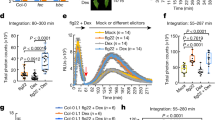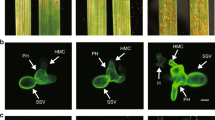Abstract
Potato late blight, caused by the destructive Irish famine pathogen Phytophthora infestans, is a major threat to global food security1,2. All late blight resistance genes identified to date belong to the coiled-coil, nucleotide-binding, leucine-rich repeat class of intracellular immune receptors3. However, virulent races of the pathogen quickly evolved to evade recognition by these cytoplasmic immune receptors4. Here we demonstrate that the receptor-like protein ELR (elicitin response) from the wild potato Solanum microdontum mediates extracellular recognition of the elicitin domain, a molecular pattern that is conserved in Phytophthora species. ELR associates with the immune co-receptor BAK1/SERK3 and mediates broad-spectrum recognition of elicitin proteins from several Phytophthora species, including four diverse elicitins from P. infestans. Transfer of ELR into cultivated potato resulted in enhanced resistance to P. infestans. Pyramiding cell surface pattern recognition receptors with intracellular immune receptors could maximize the potential of generating a broader and potentially more durable resistance to this devastating plant pathogen.
This is a preview of subscription content, access via your institution
Access options
Subscribe to this journal
Receive 12 digital issues and online access to articles
$119.00 per year
only $9.92 per issue
Buy this article
- Purchase on Springer Link
- Instant access to full article PDF
Prices may be subject to local taxes which are calculated during checkout




Similar content being viewed by others
References
Fisher, M. C. et al. Emerging fungal threats to animal, plant and ecosystem health. Nature 484, 186–194 (2012).
Fry, W. E. Phytophthora infestans: the plant (and R gene) destroyer. Mol. Plant Pathol. 9, 385–402 (2008).
Vleeshouwers, V. G. A. A. et al. Understanding and exploiting late blight resistance in the age of effectors. Annu. Rev. Phytopathol. 49, 507–531 (2011).
Raffaele, S. et al. Genome evolution following host jumps in the Irish potato famine pathogen lineage. Science 330, 1540–1543 (2010).
Haverkort, A., Struik, P., Visser, R. & Jacobsen, E. Applied biotechnology to combat late blight in potato caused by Phytophthora infestans. Potato Res. 52, 249–264 (2009).
Kawchuk, L. M. et al. Tomato Ve disease resistance genes encode cell surface-like receptors. Proc. Natl Acad. Sci. USA 98, 6511–6515 (2001).
Jones, D. A., Thomas, C. M., Hammond-Kosack, K. E., Balint-Kurti, P. J. & Jones, J. D. Isolation of the tomato Cf9 gene for resistance to Cladosporium fulvum by transposon tagging. Science 266, 789–793 (1994).
Thomma, B. P., Van Esse, H. P., Crous, P. W. & De Wit, P. J. Cladosporium fulvum (syn. Passalora fulva), a highly specialized plant pathogen as a model for functional studies on plant pathogenic Mycosphaerellaceae. Mol. Plant Pathol. 6, 379–393 (2005).
Ron, M. & Avni, A. The receptor for the fungal elicitor ethylene-inducing xylanase is a member of a resistance-like gene family in tomato. Plant Cell 16, 1604–1615 (2004).
Song, W. Y. et al. A receptor kinase-like protein encoded by the rice disease resistance gene Xa21. Science 270, 1804–1806 (1995).
Zipfel, C. & Robatzek, S. Pathogen-associated molecular pattern-triggered immunity: veni, vidi...? Plant Physiol. 154, 551–554 (2010).
Ponchet, M. et al. Are elicitins cryptograms in plant-oomycete communications? Cell. Mol. Life Sci. 56, 1020–1047 (1999).
Jiang, R. H. Y., Tyler, B. M., Whisson, S. C., Hardham, A. R. & Govers, F. Ancient origin of elicitin gene clusters in Phytophthora genomes. Mol. Biol. Evol. 23, 338–351 (2006).
Levesque, C. A. et al. Genome sequence of the necrotrophic plant pathogen Pythium ultimum reveals original pathogenicity mechanisms and effector repertoire. Genome Biol. 11, R73 (2010).
Cooke, D. E. et al. Genome analyses of an aggressive and invasive lineage of the Irish potato famine pathogen. PLoS Pathog. 8, e1002940 (2012).
Vleeshouwers, V. G. A. A. et al. Agroinfection-based high throughput screening reveals specific recognition of INF elicitins in Solanum. Mol. Plant Pathol. 7, 499–510 (2006).
Torto, T. A. et al. EST mining and functional expression assays identify extracellular effector proteins from the plant pathogen Phytophthora. Genome Res. 13, 1675–1685 (2003).
van Os, H. et al. Construction of a 10,000-marker ultradense genetic recombination map of potato: providing a framework for accelerated gene isolation and a genomewide physical map. Genetics 173, 1075–1087 (2006).
Potato Genome Sequencing Consortium et al. Genome sequence and analysis of the tuber crop potato. Nature 475, 189–195 (2011).
Chinchilla, D. et al. A flagellin-induced complex of the receptor FLS2 and BAK1 initiates plant defence. Nature 448, 497–500 (2007).
Heese, A. et al. The receptor-like kinase SERK3/BAK1 is a central regulator of innate immunity in plants. Proc. Natl Acad. Sci. USA 104, 12217–12222 (2007).
Chaparro-Garcia, A. et al. The receptor-like kinase SERK3/BAK1 is required for basal resistance against the late blight pathogen Phytophthora infestans in Nicotiana benthamiana. PLoS ONE 6, e16608 (2011).
Bar, M. & Avni, A. EHD2 inhibits signaling of leucine rich repeat receptor-like proteins. Plant Signal. Behav. 4, 682–684 (2009).
Haas, B. J. et al. Genome sequence and analysis of the Irish potato famine pathogen Phytophthora infestans. Nature 461, 393–398 (2009).
Lacombe, S. et al. Interfamily transfer of a plant pattern-recognition receptor confers broad-spectrum bacterial resistance. Nature Biotechnol. 28, 365–369 (2010).
Acknowledgements
We thank Paul Birch for providing P. infestans strains 88069td and EC1_DC2005, Gert van Arkel, Nic Boerboom, Nicolas Champouret, Luigi Faino, Marjan Bergervoet and Alireza Salami for technical assistance in ELR cloning and transformation, Rients Niks, Jack Vossen and Matthieu Joosten for helpful discussions and supervision, Sebastian Schornack for excellent help with microscopy, and Cyril Zipfel for useful suggestions. This work was supported by a NWO-VIDI grant 12378 (V.G.A.A.V.), the Wageningen University Fund (WUF) (J.D.), the China Scholarship Council Program for Graduate Students (J.D.), Avebe (E.V., G.B., V.G.A.A.V.), the Gatsby Charitable Foundation (A.C.G., S.K.), the European Research Council (ERC) (A.C.G., S.K.) and the Biotechnology and Biological Sciences Research Council (BBSRC) (A.C.G., S.K.).
Author information
Authors and Affiliations
Contributions
J.D., E.V., A.C.G., G.B., L.C.P., J.Z. and V.G.A.A.V. performed experiments and analysed data; T.W.H.L. and F.G. contributed constructs; J.D., E.V., A.C.G., E.A.G.v.d.V., C.X., J.Z., S.R., S.K. and V.G.A.A.V. designed experiments; E.A.G.v.d.V., C.X., S.R., S.K., V.G.A.A.V., E.J. and R.G.F.V. supervised; J.D., E.V., A.C.G., S.K. and V.G.A.A.V. wrote the manuscript.
Corresponding author
Ethics declarations
Competing interests
The authors declare no competing financial interests.
Supplementary information
Rights and permissions
About this article
Cite this article
Du, J., Verzaux, E., Chaparro-Garcia, A. et al. Elicitin recognition confers enhanced resistance to Phytophthora infestans in potato. Nature Plants 1, 15034 (2015). https://doi.org/10.1038/nplants.2015.34
Received:
Accepted:
Published:
DOI: https://doi.org/10.1038/nplants.2015.34
This article is cited by
-
Leucine-Rich Repeat Receptor-Like Proteins in Plants: Structure, Function, and Signaling
Journal of Plant Biology (2023)
-
Amplification of cell signaling and disease resistance by an immunity receptor Ve1Ve2 heterocomplex in plants
Communications Biology (2022)
-
Genetic and physiological characterization of sunflower resistance provided by the wild-derived OrDeb2 gene against highly virulent races of Orobanche cumana Wallr
Theoretical and Applied Genetics (2022)
-
Selection and characterization of in vitro–induced mutants of Dendrobium ‘Earsakul’ resistant to black rot
In Vitro Cellular & Developmental Biology - Plant (2022)
-
Tools for engineering resistance against pathogens in plants
Journal of Plant Biochemistry and Biotechnology (2022)



